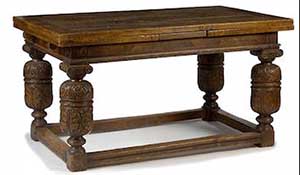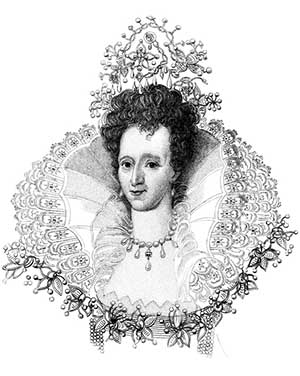The Tudors, perhaps the most famous monarch dynasty, ruled the Kingdom of England from 1485 to 1603. The last of the rulers to bear the name Tudor was Elizabeth who became queen in 1558. During the reign of Elizabeth Tudor, England turned into a maritime power and one of the most influential parties in international trade. As England grew richer, it developed a strong interest in art and especially the works of Italian, French, Flemish, and Dutch masters. Eventually, the refinement of tastes resulted in the emergence of new trends in architecture and applied art. Although the designs introduced during this period formally belong to the last phase of the Tudor style, they were so distinct that Elizabeth secured her own name for the style appellation.
Elizabethan antiques are rare and valuable. Many of the items created in the second half of the 16th century turned into museum exhibits. Nevertheless, if you intend to purchase 400+ years old antiques, it won’t hurt to learn about their distinctive features.
The Birth of Elizabethan Woodwork Art

The Elizabethan era was marked by the transition from Gothic to Renaissance (hence the style is also called Elizabethan Renaissance). If earlier building construction had safety as the main priority, the newly-occurring trends called for comfort. The windows got larger to let in as much light as possible, the stairs became wider, and the furniture gained an eye-pleasing quality. Embracing the styles that originated in Europe, architects endowed houses with a lot of space, and it was used to entertain guests. More space required more furniture, and local craftsmen walked the extra mile to meet the demand.
Although the simultaneous impact of Gothic and Renaissance made the Elizabethan style eclectic, the interior design started gravitating towards the unity of the ensemble. Elizabethan furniture and interior items were massive and generously adorned with carvings. The heavy and tough oak, which is the hallmark of the Tudor style, was gradually giving way to lighter woods including ash, yew, and walnut. The wood species can give a hint where a particular piece of furniture was used. Halls tended to accommodate oak pieces that could withstand hard use. Items made of more fragile woods became the feature of galleries. Unfortunately, fine wood furniture has barely survived to this day due to the lack of wear-and tear resistance.
Ornate Carvings Became Popular
As furniture and interior items became available in greater quantities, their quality soared, and the furniture making craft became more prestigious. It was during the Elizabethan period that craftsmen commenced leaving a maker’s mark on the items they produced. Furnishings ceased to be plain and unadorned. Everything that could be carved was carved. The most popular designs included diamond-shaped (lozenge) and strapwork patterns, flowers and fruits (especially vine), masques, grotesques, and so on.
To many, this riot of ornaments may seem all over the place but the arising skill of woodworkers became a harbinger of refined designs emerging in subsequent periods. Also, the quality and quantity of carvings may indicate where the antiques of the early Elizabethan period were made. Continental craftsmen had more taste, skill, and a sense of proportion compared to their English counterparts. Fortunately, as their skills improved, English cabinetmakers developed more proficiency in carving and ornamentation.
Elizabethan Era Home Décor Antiques
Elizabethan antiques survived to this day testify to the luxury and, simultaneously, simplicity of that era’s interiors. The staple of the rooms was a snow-white ceiling bearing a lozenge ornament and framed by stucco cornices. More often than not, gilding or a coat of paint offering a dramatic colour covered decorative stucco mouldings.
Walls rarely accommodated paintings (with the exception of large family estates). The role of decorations was given to murals, frescoes, wall plaques, as well as tapestries with silver or gold threads. Another popular approach to wall embellishment was textiles featuring images of historical events or nature. Besides the walls, textiles adorned furniture and tables. The lower portion of the walls normally had carved oak panels. Fireplaces boasted slabs of coloured marble or carved stone, and chimneys displayed intertwining patterns similar to those of ceilings.
The colour range of home décor items of the Elizabethan era wasn’t particularly diverse. The most common were the colours of wood, stone or plaster, and only decorative elements could benefit from red, green, and other vivid colours.
Glass Art & Glass Object Were Rare
Although England had already learned to produce glass by the time Elizabeth Tudor ascended the throne (hence the houses of the nobility had glass windows instead of shutters), this material remained quite rare. Glass mirrors were a luxury even for people with deep pockets. Those scarce products available for sale were brought from Europe, mainly from Venice. In the same vein, glassware was few and far between. The most common materials for making utensils (such as decorative goblets and cups) were pewter, silver, and gold.
The homes of the nascent middle class and especially the poor were a far cry from sumptuousness available to the rich. However, commoners also felt the need to decorate their dwellings, especially when home decor items and accessories were no longer a rarity. They utilised tapestries, hangings, embroidered linen tablecloths and cushions, as well as needlework cloths to make their homes cosier.
Antique Elizabethan Jewellery
The majority of Elizabethan-era jewellery did not have the faceted stones that we are used to. Jewellery-making hasn’t yet had tools and skills to beautifully cut precious stones. Most of the gems in the 16th century were smooth and polished such as domed cabochons or flat table-cuts. As the new century dawned, jewellers made significant progress in the hard gemstones processing and were able to introduce real sparklers carrying hog-back, pyramid, and rose cuts. The list of the most coveted jewels included emerald, ruby, sapphire, topaz, opal, and diamonds
On the other hand, when it comes to softer semi-precious minerals, jewellers were vying with each other to offer cameos featuring intricate silhouettes reminiscent of animals, ships, female faces, etc. They used onyx, chalcedony, sardonyx, carnelian, jasper, and turquoise to carve their masterpieces. Enamel was another common way to add a vibrant focal point to a piece of jewellery.
All this splendour was set in gold. Antique settings didn’t have prongs. Instead, the precious metal enclosed the bottom of a stone and frequently took the shape of leaves, flowers, or petals.
Items you could see on the necks of the nobility and prosperous merchants included single or layered gold chains or strands of pearls, wide chokers (carcanets), and collars. More often than not, neck jewellery carried beads of gold or gemstones, as well as enamel inlays.
Brooches that flourished in the Tudor era fell out of favour in Elizabethan England. Pendants took over their role as adornments for gowns, hair, and girdles (predecessors of belts). Made of gold and various gemstones, they tended to feature a pearl or a cluster of pearls dangling at the bottom. Early pendants were shaped like crosses or cameos displaying religious themes or scenes from life. Later they acquired more intricate designs such as swans, flowers, birds, fish, spiders, and others. Miniature paintings were in vogue as well. They accompanied a locket or pendant.
Elizabethan antique rings offered a few popular designs: solitaires, cluster rings, gem-clad bands, wedding rings with engraving, and signets. The letter design was made sturdy as it doubled as a stamp to mark documents. The middle class had their initials on the signets while the nobility preferred rings with family crests.
Elizabethan England got rid of headwear covering the ears and this nudged fashionistas into rediscovering earrings. Some of them were simple – rings, a single pearl, or a gem. Others were multi-tiered, with a central stone and a large pendant hanging from it. Probably the most original earrings featured ribbons that were threaded into the ear with a needle and tied in a bow.

